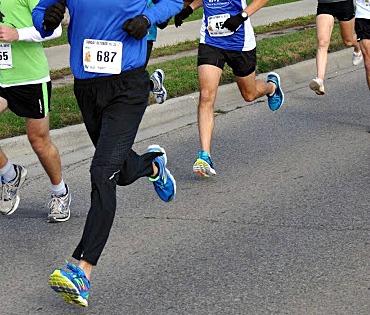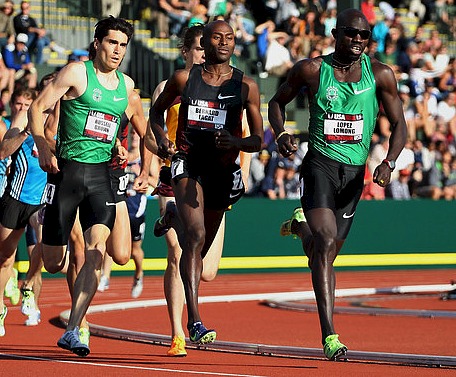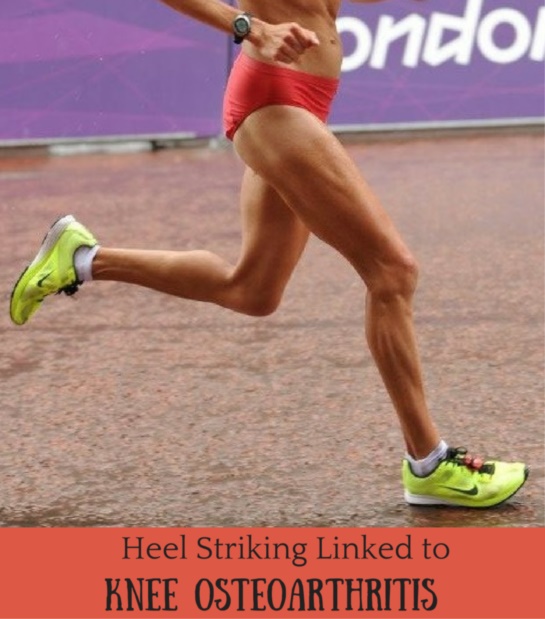If you want to protect your knees during running, you’ll need to avoid heel striking altogether. Why? Because heel strike running increases the risk of knee osteoarthritis, a degenerative joint disease of the knee cartilage, underlying bone, and surrounding ligaments, and is also one of the main reasons for knee replacements (Plack 2015).
How Heel Strike Running Leads to Knee Osteoarthritis
Unsurprisingly, one way a runner can get osteoarthritic knees is by heel strike running.
There are many factors of heel strike running that cause osteoarthritic knees. These factors include: braking, maximum knee extension, over-striding and the heel strike-transient at touchdown, all of which increases mechanical stress on the knee, and eventually leads to knee-joint deformities that alter knee-joint mechanics which increases cartilage degeneration.
Moreover, the repetitive, high-impact movements of heel strike running increases mechanical stresses beyond the threshold of the knee-joint leading to a progressive loss of hyaline cartilage, femoral cartilage and articular cartilage. Ouch!

Even more concerning, changes in knee-joint health becomes evident as soon as a runner begins heel strike running (Hohman et al.)
Surprisingly though, many experts believe that recreational running, where heel striking is the predominant foot strike, does not cause osteoarthritic knees across time. However, new reports have found evidence to the contrary.
- Hohman et al. found that joggers who ran their first marathon had MRIs that showed negative long-term biomechanical changes to articular cartilage in the knee joint –this was one of the few studies that used MRIs to measure knee-joint health in relation to osteoarthritis development.
Heel Strike vs Forefoot Strike
Most recreational runners heel strike and the injury rate among these runners is around 79.3%, knee injuries being one of the most common. So, let’s consider the following:
- The knee is a joint and osteoarthritis is a joint disease.
- Heel strike running produces the greatest amount of knee loads than forefoot running, suggesting that the most effective way to save your knees is by running with a forefoot strike.
By comparison, elite distance runners typically have healthy knee joints, not because these runners are more conditioned, but because they don’t heel strike while running, shown below.

Mechanically, forefoot running reduces knee-joint loading and extreme torque to the point where it’s considered necessary for articular cartilage health. Overall, the knee-joint is in a better physiological state in forefoot running than in heel strike running, allowing a forefoot runner the advantage to safely increase training volume/intensity without placing a greater risk of developing ailments of the knee.
One last note, heel strike running is not the only contributing factor to knee pain in runners. Find out how orthotics damage the knee, too. Also, read this article on how knee braces exacerbate knee pain in runners!
More From Run Forefoot:
Non-Heel Strike Landing Helps Back Pain – Find out why the farther you land away from your heels during running, the less impact on the back.
Why Older Runners Need Barefoot Shoes – Learn how barefoot like running shoes can help any runner, especially older runners, stay injury-free.
How to Make Your Stride Smooth – Research suggests that stride smoothness depends on foot strike.
Running with Rigidity – Find out why heel strike runners have a more ‘choppy’, rigid gait than forefoot runners and why gait rigidity may cause injury.
More Bad News on Traditional Running Shoes – Here I talk about how traditional running shoes influence poor performance.
Proper Running Shoes – Need help finding the right shoe for forefoot running? Here are my reviews on barefoot like running shoes that will help you maintain your forefoot strike and keep your legs and feet strong.
If you like the what you read here, you’ll love the Run Forefoot Facebook Page, it’s a terrific place to ask forefoot/barefoot running questions. I’ll be happy to answer them for ya!
References:
American College of Rheumatology. Osteoarthritis. 2012; [cited 2014 Feb 27]. Available from: http://www.cdc.gov/arthritis/basics/osteoarthritis.htm
Bosomworth NJ. Exercise and knee osteoarthritis: benefit or hazard? Can Fam Physician. 2009;55(9):871Y8.
Centers for Disease Control. Osteoarthritis. 2011; [cited 2013 Apr 7]. Available from: http://www.cdc.gov/arthritis/basics/osteoarthritis.htm
Felson DT. Obesity and vocational and avocational overload of the joint as risk factors for osteoarthritis. J Rheumatol. 2004;(Suppl):2Y5.
Hohmann E, Wortler K, Imhoff AB. MR imaging of the hip and knee before and after marathon running. Am J Sports Med. 2004;32(1): 55Y9.
Plack, L. Can running cause osteoarthritis? ACSM’s Health & Fit J, 2015; 19(1):23.
Van Gent R, Siem D, van Middelkoop M, Van Os A, Bierma-Zeinstra S, Koes B. Incidence and determinants of lower extremity running injuries in long distance runners: a systematic review. Br J Sports Med. 2007;41(8):469Y80.
Bretta Riches
BSc Neurobiology; MSc Biomechanics candidate, ultra minimalist runner & founder of RunForefoot. I was a heel striker, always injured. I was inspired by the great Tirunesh Dibaba to try forefoot running. Now, I'm injury free. This is why I launched Run Forefoot, to advocate the health & performance benefits of forefoot running and to raise awareness on the dangers of heel striking, because the world needs to know.
Latest posts by Bretta Riches (see all)
- Can You Run In Barefoot Shoes? Yes, But DON’T Heel Strike! - 21/07/2024
- Why Cushioned Running Shoes Are Really Bad for Your Feet - 19/07/2024
- Do Cushioned Running Shoes Cause Injuries? - 17/07/2024


Just what the doctor orerdde, thankity you!